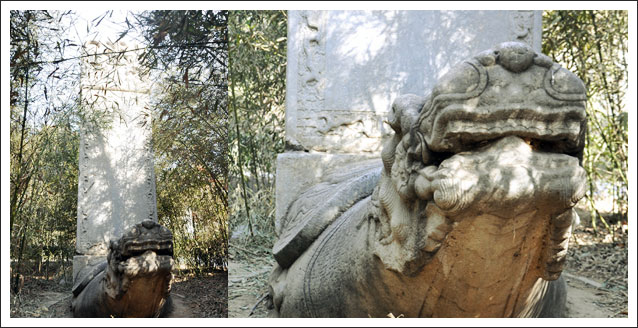文物保护

杭爱碑 Hang Ai Monument
文物时间:清康熙
文物位置:静园草坪北侧的东西两角,一院和六院前
文物类别:碑刻
Time: Kangxi period, Qing Dynasty.
Location: In the north and south corners of the east side of Jingyuan meadow, in front of no.1 dorm and no.6 dorm.
Catogory:Stone inscription
文物特色
杭爱碑从形制上看,两米多高,是清代常见的一种石碑。石碑基座是一种看起来像乌龟的动物,是传说中龙的九子之一,又名赑(音同币),形似龟,生性好负重,所以常以其作为石碑的基座。在碑顶又雕刻有一种像龙的动物,称为螭,也是龙的九子之一,形似兽,本性好登高远望,因此常被作为石碑顶部的装饰物。这种碑是实用性与艺术性结合的珍贵文物。
杭爱碑上的字已漫漶不清。据碑文推测,碑的主人是康熙时功臣杭爱。东面的那座是康熙二十四年二月杭爱去世两年以后敕建的石碑,以表彰他一生的功绩;西面的碑是同年九月礼部侍郎中稚虎的祭文,整体古朴庄严。
名人故事
杭爱,满洲人,姓章佳氏,原属正黄旗,后改隶镶白旗。杭爱成长于有学识的满洲家庭,在吴三桂叛乱期间,受到康熙的器重。后在四川任上,整饬土地,兴修水利,政绩卓著,在都江堰,至今还有杭爱的功德铭。康熙二十二年,杭爱卒,皇帝赐谥号“勤襄”,意为勤于政事,能够襄理朝廷。
历史溯源
石碑原来立于六院和俄文楼之间的土山上,燕京大学大规模兴建新校址时移于现在的地方。燕大在明清时期属西山,这里碧水澄澈,杭爱死后葬在这个风水宝地是极有可能的。今天未名湖周围地区大致就是当初赐予和珅的淑春园。因此,康熙二十二年杭爱葬于此应该在淑春园兴建之前。
Distinguishing feature
Hang Ai Tablet’s shape is common in Qing Dynasty. Up to two meters, the foundation is a tortoise-like animal, named Bei. According to ancient Chinese mythology, the dragon had nine sons, but none of them became a real dragon. Bei was one of them and loves to carry heavy stuff. So its images are usually used as foundation of tablets. There is another son of dragon was carved on the top of tablet, named Chi, likes to climb high and look out, so be used as the decoration on the top of tablet. The combination of practical utility and artistic quality makes this kind of tablet a rare cultural relic.
The words on the Tablet have been indecipherable already. According to the content, the owner of this tablet was the great statesman Hang Ai in Kangxi period. The north one was built in twenty-fourth year in Kangxi period, two years after Hang Ai's death, in order to commend his contribution during lifetime. The west one inscribed the funeral oration of the Ministry of Rites Shi Lang Zhihu, simple but solemn.
Celebrity Story
Hang Ai, Manchurian, with the surname of Janggiya Hala, once belong to yellow banner, and then moved to embed white banner. He grew in an educational family, and gained the Kangxi's attention during Wu Sangui's rebellion. Later on his term in Sichuan, he had a lot of achievements, such as rectifing the soil, launching water conservancy projects. Even now in Dujiang Dam there is a merit inscription of Hang Ai. He died in the 22th year in Kangxi period. The emperor gave him a posthumous title name called QingXiang, meaning his diligence and capability on government affairs.


